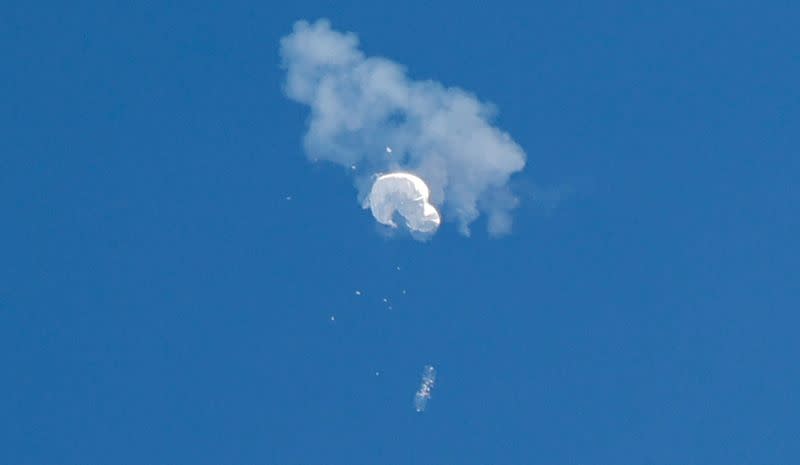U.S. adds 6 Chinese entities tied to balloon program to export blacklist

By Alexandra Alper and Karen Freifeld
WASHINGTON (Reuters) -The Biden administration on Friday added six Chinese entities connected to Beijing's suspected surveillance balloon program to an export blacklist.
The new restrictions come after the White House said it would consider broader efforts to "expose and address" China's larger surveillance activities that threaten U.S. national security and allies.
The Commerce Department said the five companies and one research institute were supporting "China's military modernization efforts, specifically the People's Liberation Army's (PLA) aerospace programs including airships and balloons."
The spectacle of the Chinese balloon drifting over the United States last week caused political outrage in Washington and brought into sharp focus the challenge that China posed to the United States and its allies.
It prompted Secretary of State Antony Blinken to cancel a trip to Beijing that both countries had hoped would patch up frayed relations.
Being added to the entity list makes it hard for targeted companies to obtain U.S. tech exports. Both U.S. President Joe Biden and his predecessor Donald Trump have used the list to punish Chinese companies viewed as a threat to national security and keep Beijing from advancing militarily.
"Today's action demonstrates our concerted efforts to identify and disrupt the PRC’s use of surveillance balloons, which have violated the airspace of the United States and more than forty countries,” said Assistant Secretary of Commerce for Export Enforcement Matthew Axelrod.
The Commerce Department said the six entities supported the modernization of China's PLA and its aerospace programs including airships and balloons.
"The PLA is utilizing High Altitude Balloons for intelligence and reconnaissance activities," said the listing posted for the Federal Register, the official U.S. daily journal.
ENTITY LIST
Two of the entities are Beijing Nanjiang Aerospace Technology and China Electronics Technology Group Corporation 48th Research Institute.
The Biden administration also added Dongguan Lingkong Remote Sensing Technology, Eagles Men Aviation Science and Technology Group, Guangzhou Tian-Hai-Xiang Aviation Technology and Shanxi Eagles Men Aviation Science and Technology Group.
An employee at Guangzhou Tian-Hai-Xiang Aviation said she was not aware of the sanctions, and declined to comment further. The company has close ties with the Chinese military, and makes aviation products for civilian and military use, according to its website.
The Chinese embassy in Washington and China Electronics Technology Group Corporation 48th Research Institute did not immediately respond to requests for comment. The government-owned 48th Research Institute produces sensors for civil and military use, according to its website.
Beijing Nanjiang, Dongguan Lingkong, Eagles Men Aviation Science and Technology Group, and Shanxi Eagles Men Aviation Science and Technology Group could not be reached.
Beijing Nanjiang is a unit of Shanghai-listed developer Deluxe Family, according to an exchange filing. The company partnered with Beihang University in developing China's first military-civilian near-space airship named "Dream", according to the official People's Daily.
Dongguan Lingkong was indirectly invested in by the Institute of Beihang University in Dongguan, which develops unmanned airships, according to public registration information. Both Eagles Men Aviation and Shanxi Eagles Men Aviation were invested in by a private equity fund promoting military-civil integration.
Washington has said it was confident the manufacturer of the Chinese balloon, which the U.S. military shot down last weekend off the U.S. east coast, has a "direct relationship" with the PLA.
The U.S. Air Force downed the balloon off South Carolina on Saturday, a week after it entered U.S. airspace. China's foreign ministry has said it was a weather balloon that had blown off course and accused the United States of overreacting.
(Reporting by Steve Holland, Karen Freifeld and Alexandra Alper; writing by Tim Ahmann and Chris Sanders; editing by Jonathan Oatis, Chris Reese, Josie Kao and Gerry Doyle)


